ASRock Fatal1ty Z77 Professional Review - IDE and Floppy on Z77
by Ian Cutress on May 20, 2012 1:30 PM EST- Posted in
- Motherboards
- ASRock
- Fatal1ty
- Z77
Test Setup
| Processor |
Intel Core i7-3770K ES 4 Cores, 8 Threads, 3.5 GHz (3.9 GHz Turbo) |
| Motherboards |
ASRock Z77 Extreme4 ASUS P8Z77-V Pro Gigabyte GA-Z77X-UD3H MSI Z77A-GD65 ASUS P8Z77-V Deluxe ASRock Fatal1ty Z77 Professional |
| Cooling | Intel All-in-One Liquid Cooler |
| Power Supply | OCZ 1250W Gold ZX Series |
| Memory |
GSkill RipjawsZ 4x4 GB DDR3-2400 9-11-11 Kit GSkill TridentX 2x4 GB DDR3-2666 11-13-13 Kit |
| Memory Settings | XMP (2400 9-11-11) |
| Video Cards |
ASUS HD7970 3GB ECS GTX 580 1536MB |
| Video Drivers |
Catalyst 12.3 NVIDIA Drivers 296.10 WHQL |
| Hard Drive | Micron RealSSD C300 256GB |
| Optical Drive | LG GH22NS50 |
| Case | Open Test Bed - CoolerMaster Lab V1.0 |
| Operating System | Windows 7 64-bit |
| SATA Testing | Micron RealSSD C300 256GB |
| USB 2/3 Testing | OCZ Vertex 3 240GB with SATA->USB Adaptor |
Power Consumption
Power consumption was tested on the system as a whole with a wall meter connected to the OCZ 1250W power supply, while in a dual 7970 GPU configuration. This power supply is Gold rated, and as I am in the UK on a 230-240 V supply, leads to ~75% efficiency > 50W, and 90%+ efficiency at 250W, which is suitable for both idle and multi-GPU loading. This method of power reading allows us to compare the power management of the UEFI and the board to supply components with power under load, and includes typical PSU losses due to efficiency. These are the real world values that consumers may expect from a typical system (minus the monitor) using this motherboard.
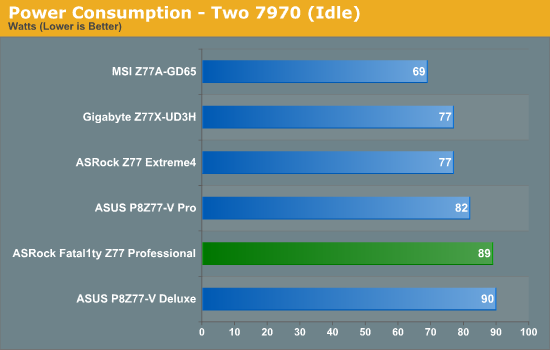
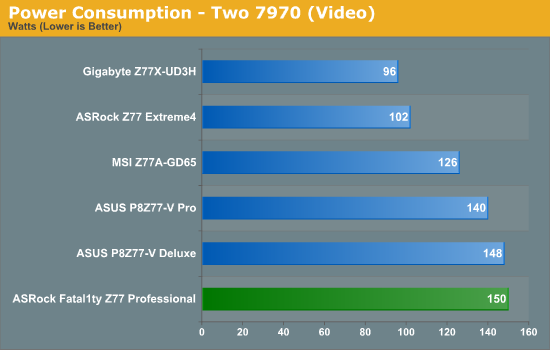
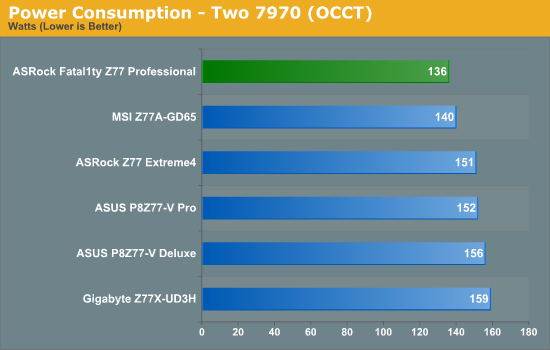
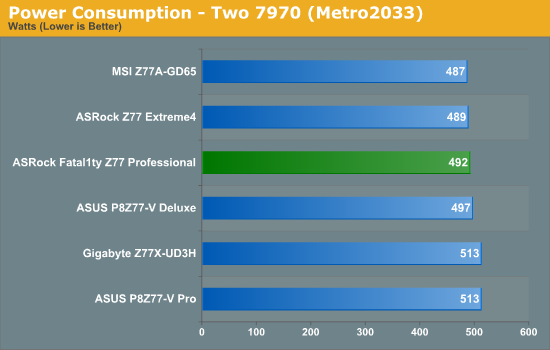
A trend I have noticed over the course of Ivy Bridge testing is that the more power phases there are on a board, the more of the phases are ‘loaded’ during moderate CPU usage, such as playing video. As these phases are at low loading individually, they are relatively inefficient than compared to high loading – this leads to a lot of power draw. As the ASRock Fatal1ty Z77 Professional has a 16+8 phase power delivery, we see this explicitly with 150W system power draw at load – 48W more than the ASRock Z77 Extreme4. There could also be other reasons for this difference, such as different signals to the GPUs regarding power required and how they power gate certain features.
POST Time
Different motherboards have different POST sequences before an operating system is initialized. A lot of this is dependent on the board itself, and POST boot time is determined by the controllers on board (and the sequence of how those extras are organized). As part of our testing, we are now going to look at the POST Boot Time - this is the time from pressing the ON button on the computer to when Windows starts loading. (We discount Windows loading as it is highly variable given Windows specific features.) These results are subject to human error, so please allow +/- 1 second in these results. As requested in my initial Z77 review, we will also be showcasing normal and ‘stripped’ POST times, whereby controllers are turned off in an attempt to get the minimum POST time.
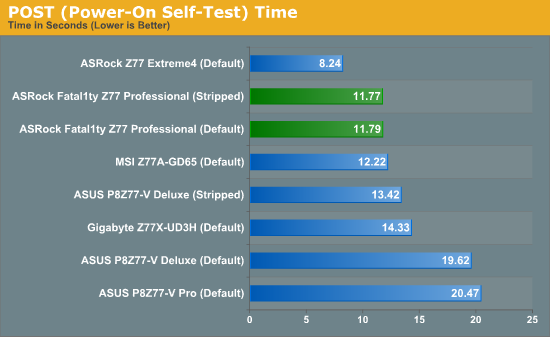
Overall, ASRock are posting some rather reasonable POST times, coming in at almost half the time of the slowest boards. It seems that the controllers on board have little effect on the POST time itself, as the stripped time comes in almost exactly the same as the default time.
Overclocks
Here at AnandTech we want to provide quick and easy ways to determine if a board is good for you (with in-depth analysis of course). So here is a quick round up of our overclocking results. Overclocks are tested for stability with PovRay and OCCT - while these may not be the most strenuous of stability tests, it does offer a quick check for memory errors under high load (and also balances testing time with getting the next board on for review!).
|
CPU Speed (MHz) |
Voltage (Volts) |
PovRay Peak Temp (ºC) |
OCCT Peak Temp (ºC) |
Notes | |
|
ASRock Fatal1ty Z77 Professional |
4700 | 1.200 | 89 | 89 | PLL Overvoltage enabled |
|
ASRock Z77 Extreme4 |
4700 | 1.175 | 86 | 86 | LLC Level 1 |
|
ASUS P8Z77-V Deluxe |
4700 | 1.225 | 89 | 84 | PLL Overvoltage enabled |
|
ASUS P8Z77-V Pro |
4700 | 1.200 | 83 | 86 | PLL Overvoltage enabled |
|
Gigabyte Z77X-UD3H |
4700 | 1.200 | 82 | 86 | LLC Extreme |
|
MSI Z77A-GD65 |
4700 | 1.250 | 90 | - | PLL Overvoltage enabled |










57 Comments
View All Comments
Senti - Monday, May 21, 2012 - link
Hell yes to IDE port. It was very frustrating to find on my new motherboard no IDE but "great" SATA 6 was there. Marvell, 2 SATA 6 ports on single PCI-E 2.0 line. Who sane would use that instead of integrated Intel RST plain SATA 3? IDE controller would be way, way more useful.The same story with PCI slots on new boards: we get 0 PCI and 7 PCI-E. But hey, if you plug something in slot X then Y won't work, or if this 1x slot is used then that 4x would become 1x. How about providing fully supplied (or at least more supplied) PCI-E ports and filling space left with PCI?
hechacker1 - Monday, May 21, 2012 - link
Yeah I like the IDE port, even if I'm going to rarely use it. They might as well shrink the header and give us a breakout cable to save space.I guess with USB 3.0, they could just give us an IDE to USB cable and solve the problem.
mapesdhs - Tuesday, May 22, 2012 - link
This is why I kept buying Asrock boards, the slot layout and choice was excellent,
eg. the P55 Deluxe is really good (I have several). Loved the 3-slot spacing for
SLI/CF, has floppy/IDE (I use SAS RAID cards which usually need a floppy for
BIOS/fw updates, and I was carrying over an IDE DVDRW), good price. Infact I
didn't think Asrock's P67 boards were as good as the P55 Deluxe.
The exception is my P67 board, an ASUS Maximus IV Extreme, because I got it for
a very low price refurb, otherwise I would likely have bought a Z68 Extreme4.
Ian.
silverblue - Monday, May 21, 2012 - link
...ATi logo on the board adjacent to the top PCI port.IanCutress - Tuesday, May 22, 2012 - link
We actually see that on a lot of boards still. Perhaps it's time for a design update :)Ian
hardslime - Monday, May 21, 2012 - link
"There are six fan headers on the board – the CPU socket has two fan headers above the top heatsink, one 4-pin and one three-pin, and two above the first PCIe x1 slot (both are three pin). Other fan headers on board are at the bottom, where we find two three-pin chassis headers."One of the chassis headers is a 4-pin. I own this board, you can also see it in some of the pictures.
Matt355 - Monday, May 21, 2012 - link
They should remove the Gamer tag and brand this as what it is, a Home Server Motherboard. 10 SATA ports, IDE, Floppy, lots of fan headers, PIC slots. Not what most Gamers are looking for but it still might sell to the home server crowd.faster - Monday, May 21, 2012 - link
Gamers are hardcore competitive. There is no way I'm going to copy the setup of someone I want to beat. I'm going to do my research and build a better system to try and squeeze out those extra framerates to give me the edge.I build a lot of systems and I have never bought a "Wendel" component and I probably never will unless it clearly beats the competition, something I have never seen from a Wendel component.
ocyl - Tuesday, May 22, 2012 - link
The fact that ASRock Fatal1ty Z77 Professional has built-in IDE and floppy connectors is one of the primary reasons why I will purchase this motherboard rather than the others in the same price range. Sure, I may never need to use these connectors again after the next system migration, but if/when I ever do in the future, I won't have to spend any additional money on expansion cards, nor will I need to allocate any PCI (Express) slot or USB port for them.On the other hand, I would have liked to see dual-link DVI, DisplayPort, and D-sub, or at least dual-link DVI and DisplayPort, instead of DisplayPort and HDMI, video output connectors on this motherboard. I have invested a lot of money in professional-grade monitors, and I am not going to swap them out simply because they are equipped with DVI connectors. Passive DisplayPort-to-DVI and HDMI-to-DVI adapters can only output single-link DVI signals.
jigglywiggly - Tuesday, May 22, 2012 - link
i have better aim that fatal1tyhttp://www.youtube.com/watch?v=on1dT4lLuWA
i have a frag of him somewhere, and every game i've played with him, my lg and rail accs are always better, 1.5x.
I still want his stuff, he is p cool, and a great dueler.
Wat u r describing is a lozer